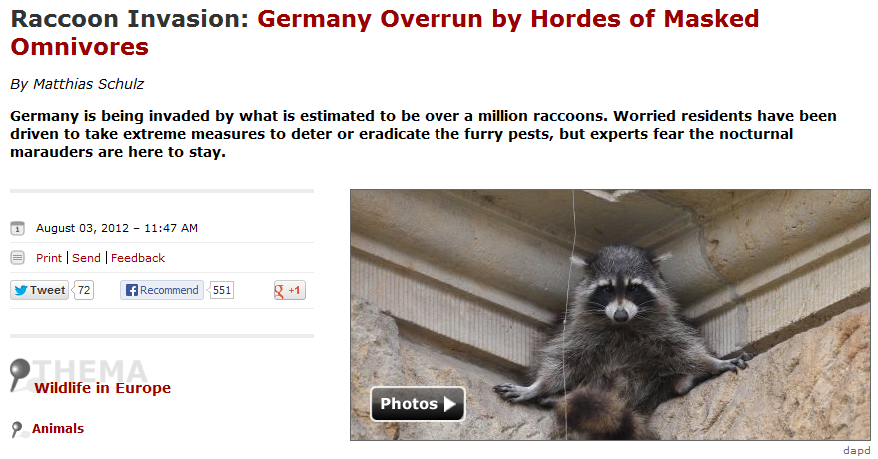 “Raccoons are going to take over the earth” comments Sarah Goodyear, after seeing the PBS documentary Raccoon Nation, which explains how raccoons are adapting to the complexities of urban living. Instead of being deterred by modern obstacles, raccoons have risen to the challenge and even seem to get smarter from the experience. This enhanced intelligence is making effective raccoon removal from homes increasingly difficult.
“Raccoons are going to take over the earth” comments Sarah Goodyear, after seeing the PBS documentary Raccoon Nation, which explains how raccoons are adapting to the complexities of urban living. Instead of being deterred by modern obstacles, raccoons have risen to the challenge and even seem to get smarter from the experience. This enhanced intelligence is making effective raccoon removal from homes increasingly difficult.
Matthias Schulz from the German newspaper Spiegel estimates that over a million raccoons are widening the range of their habitat in the German states of Hesse, Brandenburg, and Saxony-Anhalt; and have already breached the limits set by humans. Originally from North America, raccoons are known for their intelligence—Native Americans even depicted them as tricksters in their legends.
Introduced to Germany in the 1920s to raise for their pelts, raccoons were eventually released into the wild on 1934 on the premise that their presence would enrich Prussian fauna. Forest biologist Ulf Hohmann noted that the raccoon population in several of German states where they were originally introduced is getting so large that some “individuals have even made it over the Alps”.
According to the German Hunting Association (DJV) there is, indeed, a raccoon invasion. Although a record-breaking 67,700 raccoons were killed in Germany during the spring of 2012, it has not significantly lowered the cases of raccoon intrusions in urban homes nor as this mass culling slowed down raccoon predation of native partridges, pheasants, bats, and even the endangered European pond turtle. The DJV says that so far, the environmental damage has been only minor; and that the only real concern is rabies, which afflicted raccoons may transmit to humans.
In Britain, as in the rest of Europe, raccoons have joined the fox in nocturnal scavenging, frequently knocking over trash bins. Unlike most U.S. states that prohibit keeping raccoons as pets, as of 2007 the U.K. has allowed people to keep these animals at home. Simon Baker, an expert on native British mammals, fears that the legislation will give rise to a raccoon problem similar to what the nation experienced with gray squirrels and wild boars.
Americans, on the other hand, find raccoons irresistibly charming. Staney Gehrt, an associate professor at Ohio State University, says that “people have a different kind of relationship with raccoons. [They] kind of identify with them. There’s an increased comfort level” explaining why Americans seemingly tolerate raccoons unlike other garbage foragers. Goodyear agreed that raccoons look “freaking adorable,” but she concedes that it’s not a good idea to adopt them.
Toronto Sun columnist Ted Woloshyn calls Toronto the “Raccoon Capital of the World” for harboring as many as 150 individuals per square kilometer. Instead of inhabiting parks and wildlife preserves, the raccoons stay mostly in neighborhoods where there is no shortage of garbage bins to scavenge in. For now, it seems that aside from ensuring that homes and bins are securely closed, professional raccoon removal from Toronto homes seems to be the only viable solution to this growing problem.


